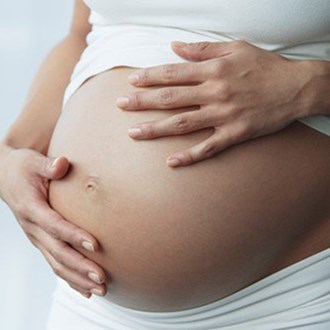Bleeding, spotting and cramping during pregnancy: What is normal?

Bleeding, spotting and cramping during early pregnancy is common, affecting around one in three women. So should you be concerned?
While often spotting and mild cramping during pregnancy is no cause for concern, it can also be a sign of spontaneous abortion (also called spontaneous miscarriage), ectopic pregnancy (the foetus implants outside the womb) or a threatened miscarriage (there is another cause of bleeding, but typically the pregnancy continues as normal).
Spotting and cramping during pregnancy causes vary, but the timing can sometimes help identify the cause. For example, spotting or cramping during early pregnancy and the first 6 weeks could indicate:
Spotting, cramping and bleeding during the first 6 weeks of pregnancy
-
Cramping during ovulation
Some women report mild cramping during ovulation (although it is rare), when the egg is released at around day 14 of an average 28 day menstrual cycle.
-
Spotting or mild cramping during Implantation
Spotting and mild cramping can occur during implantation, which is when the fertilised embryo burrows into the highly vascular lining of the uterus around 6-9 days after fertilisation or ovulation (in an average 28-30 day cycle).
-
Pain, spotting or cramping indicating an ectopic pregnancy
An ectopic pregnancy occurs when the fertilised egg grows outside the uterus (womb). Most ectopic pregnancies occur inside the fallopian tubes. Ectopic pregnancies need to be treated immediately. Early detection can sometimes help save the fallopian tube, and prevent other serious medical complications including a rupture of fallopian tube, internal bleeding, infection and more.
While many women who have spotting and cramping during pregnancy go on to have healthy pregnancies and babies, any sign of bleeding, spotting or cramping should be investigated by your caregiver immediately.

Why does spotting during pregnancy occur?
Spotting or bleeding during pregnancy is the result of any blood discharge from the vagina. It can occur at any time during pregnancy, from conception to the birth.
Spotting and light bleeding during pregnancy affects around two in three women. Often spotting or bleeding is no cause for concern, however any blood discharge should be investigated by your primary caregiver as a precautionary measure.
Bleeding during early pregnancy - before 6 weeks
It’s very difficult to detect the baby’s heartbeat before six weeks because the embryo is so small. However, if bleeding, spotting or cramping occur around six weeks pregnancy, your caregiver may suggest a vaginal ultrasound.
This is ultrasound is performed using an internal probe, and is not dissimilar to an internal examination or paps smear. The purpose of the internal ultrasound is to determine if there is a heartbeat, evidence of a miscarriage or if the embryo is still growing. If the embryo is growing, you may go on to have a normal healthy pregnancy. If there is no heartbeat or evidence of a miscarriage, your doctor will advise next steps (some women who do not have a ‘complete miscarriage’ require a curette).

Spotting, cramping or bleeding after 12 weeks
The further your pregnancy develops, the lower the risk of miscarriage.
he 12 week ultrasound go on to have successful births. Spotting during pregnancy could be caused by sex, polyps, cervical changes, or other non-threatening causes.
However, spotting, cramping and bleeding at or after 12 weeks can indicate a number of conditions which require medical attention and care. These include: vaginal infection, placenta problems (low lying placenta, placenta abruption), a show (sign of early labour) and more.
Spotting and cramping in conjunction
Research indicates that 1 in 4 women will experience bleeding and/or pain during their first 12 weeks of pregnancy. After 12 weeks, the risk of miscarriage drops significantly. Between weeks 13 and 20, the risk of experiencing a miscarriage is less than 1 percent. Around half of these pregnancies will continue to grow and develop as normal. However, unfortunately half may also end in miscarriage, which cannot be prevented. There are a range of reasons why spontaneous abortion (or miscarriage) occurs, including genetic abnormalities.
Pink or brown discharge during pregnancy: What causes it and what does it mean?
There are a number of possible causes for pinkish or brownish discharge during pregnancy. These can include:
Cervical irritation: The cervix is highly vascular and if irritated by sex, an internal examination by your doctor or a vaginal ultrasound, or infection, it may produce a pinkish-brownish discharge (pink indicates new blood whereas brown indicates older blood).
Mucus plug: The mucus plug protects the cervix and basically plus up the opening to prevent bacteria or other foreign substances from entering the women. The mucus plug can dislodge (typically) between 36-40 weeks and is a ‘show’ or sign of early labour. The mucus plug is a brownish colour and can dislodge as a large chunk or smaller pieces.
Should you see a doctor if you have spotting and cramping pregnancy?
Yes. Your doctor or primary carer may investigate the spotting and cramping causes according to how many weeks pregnant you are through one or multiple tests. These tests could include:
- blood tests to test your hormone levels are in accordance with your pregnancy weeks.
- urine test
- internal examination to feel the size of your uterus and to investigate any possible signs or symptoms of the bleeding and cramping
- ultrasound

Franki Hobson is a women’s lifestyle journalist and editor with more than twenty years’ experience. Her areas of expertise include parenting and health and well-being. Franki has two gorgeous boys, Maxwell, 10, and Louis, 1 ½.







